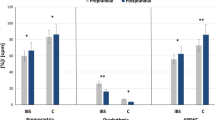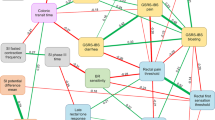Abstract
Background
Postprandial symptoms in irritable bowel syndrome (IBS) have been associated with increased bowel contractility.
Aim
To compare ileocolonic and colonic responses to feeding in health and IBS.
Methods
We prospectively analyzed data from separate research trials in 122 IBS patients and 41 healthy volunteers. Ileocolonic transit (ICT) was evaluated before (colonic filling [CF]3h) and immediately after (CF4h) a standard lunch at 3 h 45 min, and 2 h thereafter. The colonic geometric center (GC) was calculated 2 h (GC6h) after lunch ingested at 4 h (GC4h) and directly after (GC8h) a standard dinner ingested at 7 h 45 min.
Results
ICT immediately after eating was higher in IBS diarrhea predominant (IBS-D) patients than in the healthy cohort (23.1 ± 2.4 vs. 17.5 ± 2.8%, P = 0.059). ICT 2 h after lunch was similar between groups (P = 0.55). There was significant overall group differences in colonic transit 2 h post-lunch (P = 0.045), particularly in the IBS constipation predominant (IBS-C; GC6–GC4, Δ0.29 ± 0.08) patients versus healthy volunteers (Δ0.56 ± 0.12 GC units).
Conclusions
After feeding, ICT is increased in IBS-D, whereas colonic transit is blunted in IBS-C.





Similar content being viewed by others
References
Saito YA, Schoenfeld P, Locke GR 3rd. The epidemiology of irritable bowel syndrome in North America: a systematic review. Am J Gastroenterol. 2002;97:1910–1915.
Ragnarsson G, Bodemar G. Pain is temporally related to eating but not to defaecation in the irritable bowel syndrome (IBS). Patients’ description of diarrhea, constipation and symptom variation during a prospective 6-week study. Eur J Gastroenterol Hepatol. 1998;10:415–421.
Lea R, Whorwell PJ. The role of food intolerance in irritable bowel syndrome. Gastroenterol Clin North Am. 2005;34:247–255.
Camilleri M, McKinzie S, Busciglio I, et al. Prospective study of motor, sensory, psychologic, and autonomic functions in patients with irritable bowel syndrome. Clin Gastroenterol Hepatol. 2008;6:772–781.
Simrén M, Månsson A, Langkilde A, et al. Food-related gastrointestinal symptoms in the irritable bowel syndrome. Digestion. 2001;63:108–115.
Duthie HL. Colonic response to eating. Gastroenterology. 1978;75:527–528.
von der Ohe MR, Hanson RB, Camilleri M. Serotonergic mediation of postprandial colonic tonic and phasic responses in humans. Gut. 1994;35:536–541.
Snape WJ Jr, Matarazzo SA, Cohen S. Effect of eating and gastrointestinal hormones on human colonic myoelectrical and motor activity. Gastroenterology. 1978;75:373–378.
Sullivan MA, Cohen S, Snape WJ Jr. Colonic myoelectrical activity in irritable-bowel syndrome. Effect of eating and anticholinergics. N Engl J Med. 1978;298:878–883.
Bassotti G, Imbimbo BP, Gaburri M, et al. Transverse and sigmoid colon motility in healthy humans: effects of eating and of cimetropium bromide. Digestion. 1987;37:59–64.
Björnsson ES, Chey WD, Ladabaum U, et al. Differential 5-HT3 mediation of human gastrocolonic response and colonic peristaltic reflex. Am J Physiol. 1998;275:G498–G505.
Delvaux M, Staumont G, Fioramonti J, et al. Alterations of colonic motility after oral administration of prostaglandin E1 analogue misoprostol in man. J Gastrointest Motil. 1992;4:33–38.
Connell AM, Jones FA, Rowlands EN. Motility of the pelvic colon. IV. Abdominal pain associated with colonic hypermotility after meals. Gut. 1965;6:105–112.
Bouchoucha M, Odinot JM, Devroede G, et al. Simple clinical assessment of colonic response to food. Int J Colorectal Dis. 1998;13:217–222.
Spiller RC, Brown ML, Phillips SF. Emptying of the terminal ileum in intact humans. Influence of meal residue and ileal motility. Gastroenterology. 1987;92:724–729.
Greydanus MP, Camilleri M, Colemont LJ, et al. Ileocolonic transfer of solid chyme in small intestinal neuropathies and myopathies. Gastroenterology. 1990;99:158–164.
Quigley EM, Phillips SF, Dent J, et al. Myoelectric activity and intraluminal pressure of the canine ileocolonic sphincter. Gastroenterology. 1983;85:1054–1062.
Thompson WG, Longstreth GF, Drossman DA, et al. Functional bowel disorders and functional abdominal pain. Gut. 1999;45(Suppl 2):II43–II47.
Talley NJ, Phillips SF, Wiltgen CM, et al. Assessment of functional gastrointestinal disease: the bowel disease questionnaire. Mayo Clin Proc. 1990;65:1456–1479.
Kruis W, Azpiroz F, Phillips SF. Contractile patterns and transit of fluid in canine terminal ileum. Am J Physiol. 1985;249:G264–G270.
Camilleri M, Colemont LJ, Phillips SF, et al. Human gastric emptying and colonic filling of solids characterized by a new method. Am J Physiol. 1989;257:G284–G290.
Hebden JM, Blackshaw PE, Perkins AC, et al. Small bowel transit of a bran meal residue in humans: sieving of solids from liquids and response to feeding. Gut. 1998;42:685–689.
Spiller RC, Brown ML, Phillips SF, et al. Scintigraphic measurements of canine ileocolonic transit. Direct and indirect effects of eating. Gastroenterology. 1986;91:1213–1220.
Leelakusolvong S, Bharucha AE, Sarr MG, et al. Effect of extrinsic denervation on muscarinic neurotransmission in the canine ileocolonic region. Neurogastroenterol Motil. 2003;15:173–186.
Bharucha AE, Seide B, Guan Z, et al. Effect of tolterodine on gastrointestinal transit and bowel habits in healthy subjects. Neurogastroenterol Motil. 2008;20:643–648.
Phillips SF, Camilleri M. The ileocecal area and the irritable bowel syndrome. Gastroenterol Clin North Am. 1991;20:297–311.
Hutchinson R, Notghi A, Smith NB, et al. Scintigraphic measurement of ileocaecal transit in irritable bowel syndrome and chronic idiopathic constipation. Gut. 1995;36:585–589.
Kamath PS, Phillips SF. Initiation of motility in canine ileum by short chain fatty acids and inhibition by pharmacological agents. Gut. 1988;29:941–948.
Spiller RC, Brown ML, Phillips SF. Decreased fluid tolerance, accelerated transit, and abnormal motility of the human colon induced by oleic acid. Gastroenterology. 1986;91:100–107.
Kamath PS, Phillips SF, O’Connor MK, et al. Colonic capacitance and transit in man: modulation by luminal contents and drugs. Gut. 1990;31:443–449.
Steed KP, Bohemen EK, Lamont GM, et al. Proximal colonic response and gastrointestinal transit after high and low fat meals. Dig Dis Sci. 1993;38:1793–1800.
Bazzocchi G, Ellis J, Villanueva-Meyer J, et al. Effect of eating on colonic motility and transit in patients with functional diarrhea. Simultaneous scintigraphic and manometric evaluations. Gastroenterology. 1991;101:1298–1306.
Di Stefano M, Miceli E, Missanelli A, et al. Meal induced rectosigmoid tone modification: a low caloric meal accurately separates functional and organic gastrointestinal disease patients. Gut. 2006;55:1409–1414.
Rao SS, Kavelock R, Beaty J, et al. Effects of fat and carbohydrate meals on colonic motor response. Gut. 2000;46:205–211.
Wright SH, Snape WJ Jr, Battle W, et al. Effect of dietary components on gastrocolonic response. Am J Physiol. 1980;238:G228–G232.
Kerlin P, Zinsmeister A, Phillips S. Motor responses to food of the ileum, proximal colon, and distal colon of healthy humans. Gastroenterology. 1983;84:762–770.
Bouchoucha M, Faye A, Devroede G, et al. Effects of oral pinaverium bromide on colonic response to food in irritable bowel syndrome patients. Biomed Pharmacother. 2000;54:381–387.
Rogers J, Henry MM, Misiewicz JJ. Increased segmental activity and intraluminal pressures in the sigmoid colon of patients with the irritable bowel syndrome. Gut. 1989;30:634–641.
Narducci F, Bassotti G, Granata MT, et al. Colonic motility and gastric emptying in patients with irritable bowel syndrome. Effect of pretreatment with octylonium bromide. Dig Dis Sci. 1986;31:241–246.
Bouchoucha M, Devroede G, Faye A, et al. Colonic response to food in constipation. Int J Colorectal Dis. 2006;21:826–833.
Bazzocchi G, Ellis J, Villanueva-Meyer J, et al. Postprandial colonic transit and motor activity in chronic constipation. Gastroenterology. 1990;98:686–693.
Björnsson ES, Chey WD, Hooper F, et al. Impaired gastrocolonic response and peristaltic reflex in slow-transit constipation: role of 5-HT(3) pathways. Am J Physiol. 2002;283:G400–G407.
O’Brien MD, Camilleri M, von der Ohe MR, et al. Motility and tone of the left colon in constipation: a role in clinical practice? Am J Gastroenterol. 1996;91:2532–2538.
Grotz RL, Pemberton JH, Levin KE, et al. Rectal wall contractility in healthy subjects and in patients with chronic severe constipation. Ann Surg. 1993;218:761–768.
von der Ohe MR, Camilleri M, Kvols LK. A 5HT3 antagonist corrects the postprandial colonic hypertonic response in carcinoid diarrhea. Gastroenterology. 1994;106:1184–1189.
Acknowledgments
Dr. Camilleri’s work in IBS is supported in part by RO1 grant DK-54681 from the National Institutes of Health.
Author information
Authors and Affiliations
Corresponding author
Rights and permissions
About this article
Cite this article
Deiteren, A., Camilleri, M., Burton, D. et al. Effect of Meal Ingestion on Ileocolonic and Colonic Transit in Health and Irritable Bowel Syndrome. Dig Dis Sci 55, 384–391 (2010). https://doi.org/10.1007/s10620-009-1041-8
Received:
Accepted:
Published:
Issue Date:
DOI: https://doi.org/10.1007/s10620-009-1041-8




